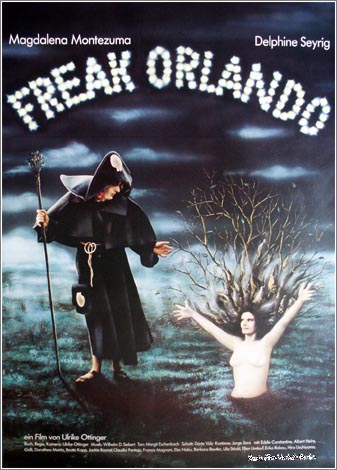 Perhaps the ultimate Freak Movie, this beyond-bizarre 1981 German phantasmagoria features human oddities of every conceivable assortment (some natural born, others created by prosthetic FX) in a surreal cavalcade the likes of which you won’t see anywhere else.
Perhaps the ultimate Freak Movie, this beyond-bizarre 1981 German phantasmagoria features human oddities of every conceivable assortment (some natural born, others created by prosthetic FX) in a surreal cavalcade the likes of which you won’t see anywhere else.
FREAK ORLANDO’S creator Ulrike Ottinger is a prolific painter, filmmaker and playwright. This, apparently her most monumental film project, is nothing if not ambitious—inspired by Virginia Wolfe’s time-tripping feminist tract ORLANDO, the film (according to a synopsis published on Ottinger’s website) means to present “a history of the world from its beginnings to our day, including the errors, the incompetence, the thirst for power, the fear, the madness, the cruelty and the commonplace, in a story of five episodes.” What that quote doesn’t reveal is that this politically incorrect film’s world is populated entirely by freaks. In other words, Ottinger’s aims are similar to those of Todd Browning’s FREAKS and Werner Herzog’s EVEN DWARFS STARTED SMALL: a vision of our world as a giant freak show, a concept FREAK ORLANDO takes farther than Browning or Herzog ever did, even if it isn’t as satisfying as those other films (see below).
FREAK ORLANDO is divided into five more-or-less distinct sections, all featuring “Freak” Orlando, a woman, played by the late Magdalena Montezuma (an Ottinger regular), who appears in various guises (and deformities) throughout.
The opening scene is an arresting one, depicting a lone traveler wandering across a barren landscape and entering the Freak City; outside its gates is a woman who literally grows plant-like from the ground.
Part one has Freak Orlando afflicted with a cone-shaped head bearing a third eye. Together with her seven dwarf friends, she pounds an anvil as entertainment for the patrons of a shopping mall. She and her minions get thrown out, though, and forced back to their home in a fairy tale forest, where they somehow all end up inside a Trojan horse.
In part two, Freak Orlando is now a two-headed prophetess whose harmonic kingdom is disrupted by a band of black leather wearing punks who carry around a large, distinctly phallic cone statue and flagellate themselves constantly. They kidnap two of Orlando’s friends, resulting in a chase back to the hated shopping mall.
Part three begins in the shopping mall, with Freak Orlando seduced by an offer made by department store employees. Catching a glimpse of herself in a mirror, she’s suddenly transported to the Spanish Inquisition, where she endures countless tortures, eventually escaping with a band of fellow sufferers.
Part four finds Freak Orlando having changed sex. “He” falls in love with one half of a pair of Siamese twins, but the other twin grows jealous and Mr. Orlando, fed up with all the whining, kills both halves.
Part five takes place in a large field where Freak Orlando hosts a “Festival of ugliness.” Crippled folks perform their various acts—which include an amputee chorus line and a midget dance—on a stage, and then Orlando crowns the winner with a trophy bearing the inscription: “Limping is the way of the crippled.”
FREAK ORLANDO is undeniably impressive conceptually, and boasts eye-popping set and costume design, but, like many other many playwrights who become filmmakers, Ulrike Ottinger has fashioned more of a filmed outdoor play than a movie (not helped by the fact that modern day scenery is always plainly, and no doubt intentionally, visible in the background). The camera never functions as anything more than a passive spectator to Ottinger’s admittedly brilliant staging, and the bland photography seems better suited to a television drama. Thus, despite its considerable virtues, FREAK ORLANDO lacks an essential ingredient indispensable to any effective film, one that similarly minded filmmakers like Alejandro Jodorowsky and Werner Herzog intuitively possess: a sense of cinema.
A fascinating and unique film, to be sure, but far from the masterpiece its creator clearly intended.
Vital Statistics
FREAK ORLANDO
Ulrike Ottinger Filmproduktion
Director/Producer/Screenplay/Cinematography: Ulrike Ottinger
Editor: Dort Volz
Cast: Magdalena Montezuma, Delphine Seyrig, Albert Heins, Claudio Pantoja, Hiro Uschiyama, Galli, Eddie Constantine, Else Nabu, Therese Zemp, Franca Magnani, Jackie Raynal, Maria Buchelt, Paul Glauer, Luc Alexander
